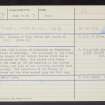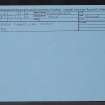Pricing Change
New pricing for orders of material from this site will come into place shortly. Charges for supply of digital images, digitisation on demand, prints and licensing will be altered.
Roxburgh, Franciscan Friary
Country House (Period Unassigned), Friary (Medieval)
Site Name Roxburgh, Franciscan Friary
Classification Country House (Period Unassigned), Friary (Medieval)
Alternative Name(s) Convent Of Grey Friars And Church Of St Peter
Canmore ID 58413
Site Number NT73SW 13
NGR NT 72037 33750
Datum OSGB36 - NGR
Permalink http://canmore.org.uk/site/58413
- Council Scottish Borders, The
- Parish Kelso
- Former Region Borders
- Former District Roxburgh
- Former County Roxburghshire
The Friary of St Peter's was located near Roxburgh, standing to the south-east of Kay Brae by the banks of the River Teviot. Its general location is fairly well known as parts of the buildings were still standing in the early nineteenth century. Today nothing survives of St Peter's, but a house named The Friars by Teviot Bridge is a reminder of their presence.
The exact year when the Franciscans built their friary remains unclear, but it is believed to have existed before 1243, and possibly as early as 1235, when the churchyard of the friary church was dedicated. The friary was occupied until the mid-sixteenth century, when it was partly destroyed in an English raid. Its lands passed to the Kers of Cessford at the Reformation.
The friars at Roxburgh were often caught up in the wars between England and Scotland. For example, in 1296, the warden of the friary delivered King John Balliol's fateful letter to Edward I of England, denying the supremacy of the English crown.
Text prepared by RCAHMS as part of the Accessing Scotland's Past project
NT73SW 13 7194 3372
(NT 7194 3372) Convent of Grey Friars and Church of St Peter (NR) (Site of)
OS 6" map, (1938).
See also NT73SW 54.
Shortly before 1243 a house of Minorites or Greyfriars was established at Roxburgh. The buildings of the House included the church of St Peter, beside which was a cemetery dedicated in 1235. The friars sold their property at the time of the Reformation to Sir Walter Ker of Cessford, and part of one building survived into the 19th century. The situation of the friary is therefore known and has been marked upon the OS map.
RCAHMS 1956.
No remains exist here.
Visited by OS (RDL) 4 December 1963.
Sbc Note (21 March 2016)
Visibility: This was the site of an archaeological monument, which may no longer be visible.
Information from Scottish Borders Council
Previously also listed under duplicate site NT96SW 510 -CANCELLED. HES (LCK) 11.6.2024
Field Visit
A country house was built for the earl of Roxburghe on the site of the Franciscan Friary, which is depicted on an estate map of 1736 titled A Survey of Floors by William Wyeth (NAS RHP 3234). The cropmarks of the Friars mansion that are visible on aerial photographs in 2006 are described under the site entry NT73SW 20.










